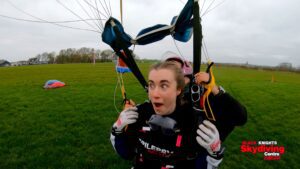What would you like to find out about today?
Other names for epilepsy with myoclonic-atonic seizures
Other names for this syndrome include:
- Doose syndrome
- Myoclonic-astatic epilepsy (MAE)
Who gets epilepsy with myoclonic-atonic seizures?
Epilepsy with myoclonic-atonic seizures (EMAtS) is not a common epilepsy syndrome. It affects around 2 out of every 100 children with epilepsy. It usually starts between the ages of 2 and 6, but may begin as young as 6 months or as late as 8 years. It’s more common in boys than girls. Around a quarter of children who develop EMAtS have had febrile seizures (seizures triggered by a high temperature).
It’s not clear exactly what causes EMAtS. But genetic factors are thought to play an important role. It’s likely that changes (mutations) in several different genes leads to the development of EMAtS in many children. About a third of children with EMAtS have a family member who has epilepsy or who has previously had febrile seizures.
Symptoms
Children with EMAtS get many different types of seizures. The main type are called myoclonic-atonic seizures, which is how the syndrome gets its name. Myoclonic means jerking movements, and atonic means the person’s muscles go floppy. You may sometimes hear the term ‘astatic’ used instead of ‘atonic’. Both of these words mean the same thing.
In a myoclonic-atonic seizure, your child makes jerking movements before their muscles go floppy. This may make them fall to the floor, or it may have a much smaller effect – like a nod of their head or jerking the upper part of their body. Your child may also get purely myoclonic or purely atonic seizures.
Other seizure types in EMAtS can include:
- Absence seizures, which cause your child to briefly appear vacant or blank
- Generalised tonic-clonic seizures, which cause your child to fall unconscious, with stiffness and jerking of the whole body
Many children with EMAtS will also have prolonged seizures at some point. These can go on for hours or days. Your child may appear drowsy, unsteady, have muscle twitches, drool and have speech problems during this time. This is called non-convulsive status epilepticus. Your child’s doctor will discuss a ‘rescue’ or emergency care plan with you to treat any prolonged or repeated seizures, including non-convulsive status epilepticus.
EMAtS often begins very suddenly, with your child experiencing lots of different seizures very often. This is sometimes called the active, ‘stormy’ or ‘explosive’ phase. During this phase, your child’s development may slow down, or even go backwards. This may affect behaviour, memory and thinking, and co-ordination. This normally improves again once seizures are under control.
Diagnosis
Your child should be referred to a specialist doctor called a paediatrician for an assessment. They’ll want to know exactly what happens when they have a seizure. It can be helpful to show the doctor a video of the seizures if you have one.
The specialist may recommend a number of tests to confirm a diagnosis. These will include an EEG (electroencephalogram), which records electrical activity in the brain. The EEG will often show unusual activity in children with EMAtS. The may be called ‘spike and wave’ or ‘polyspike and wave’ activity. This activity may increase when your child is asleep. Children with EMAtS are not usually photosensitive (seizures triggered by flashing lights).
Your child’s doctor may also suggest an MRI (magnetic resonance imaging) brain scan and blood tests. These will usually be normal in EMAtS.
The paediatrician will probably also refer to you a specialist children’s doctor with expertise in epilepsy, called a paediatric neurologist. This is because of your child’s age and also because the seizures may be difficult to control.
Treatment
The National Institute for Health and Care Excellence (NICE) has guidance for treating epilepsy with myoclonic-atonic seizures (Doose syndrome). Our information about treatment is based on this guidance. Treatment of epilepsy with myoclonic-atonic seizures is often very difficult. Your child’s doctor will discuss their treatment with a paediatric neurologist.
Your child should be offered the epilepsy medicines sodium valproate or levetiracetam as the first option for treating EMAtS. If the first one they try doesn’t work, they should try the other one.
Sodium valproate can harm an unborn baby if taken during pregnancy. If there’s any possibility of your child being able to get pregnant, or they might do in the future, their doctor should explain the risks and benefits of taking sodium valproate. They should also make sure your child is using effective contraception, as soon as they are old enough.
If sodium valproate and levetiracetam don’t help with your child’s seizures, their doctor may suggest trying a special diet, called the ketogenic diet. This is often in addition to epilepsy medicine. If this doesn’t help, they may suggest trying some other medicines. These include:
- Clobazam
- Ethosuximide
- Topiramate
- Zonisamide
Surgery is not usually carried out for children with EMAtS. Therefore they don’t need to be referred for an assessment for epilepsy brain surgery.
Outlook
It’s common for epilepsy medicines not to work at first in this syndrome. But around two thirds of children find that their seizures eventually stop, usually within 3 years of them starting, although sometimes it takes a little longer. If your child hasn’t had any seizures for around 3 years, the paediatrician may consider weaning them off any medicines they’re taking.
Behaviour and development problems are common when your child is in the ‘active’ phase. This is the time when they are having lots of seizures or if they have to take more than one epilepsy medicine at the same time. These generally get better or go away completely once their seizures are under control. Some children may be left with some learning and development difficulties.
Around a third of children with EMAtS continue to get seizures, despite treatment with epilepsy medicines and the ketogenic diet. These children usually continue to have learning and behaviour problems, especially hyperactivity and aggression. Your child’s specialist should be able to give you advice about getting support with learning and behaviour difficulties if needed.
Support
Contact – for families with disabled children
Freephone helpline: 0808 808 3555
Email: helpline@contact.org.uk





